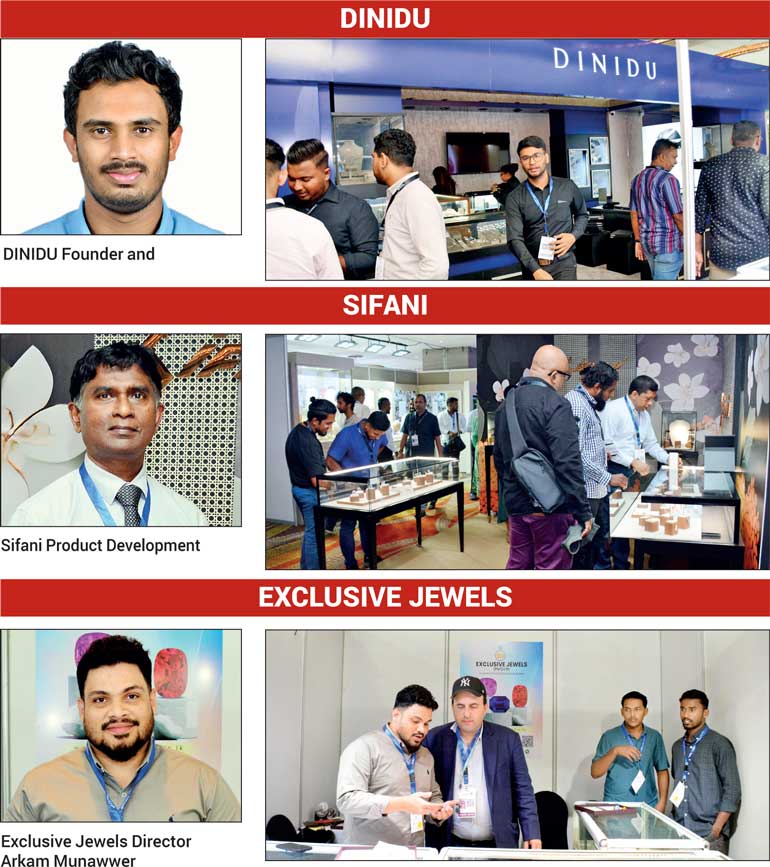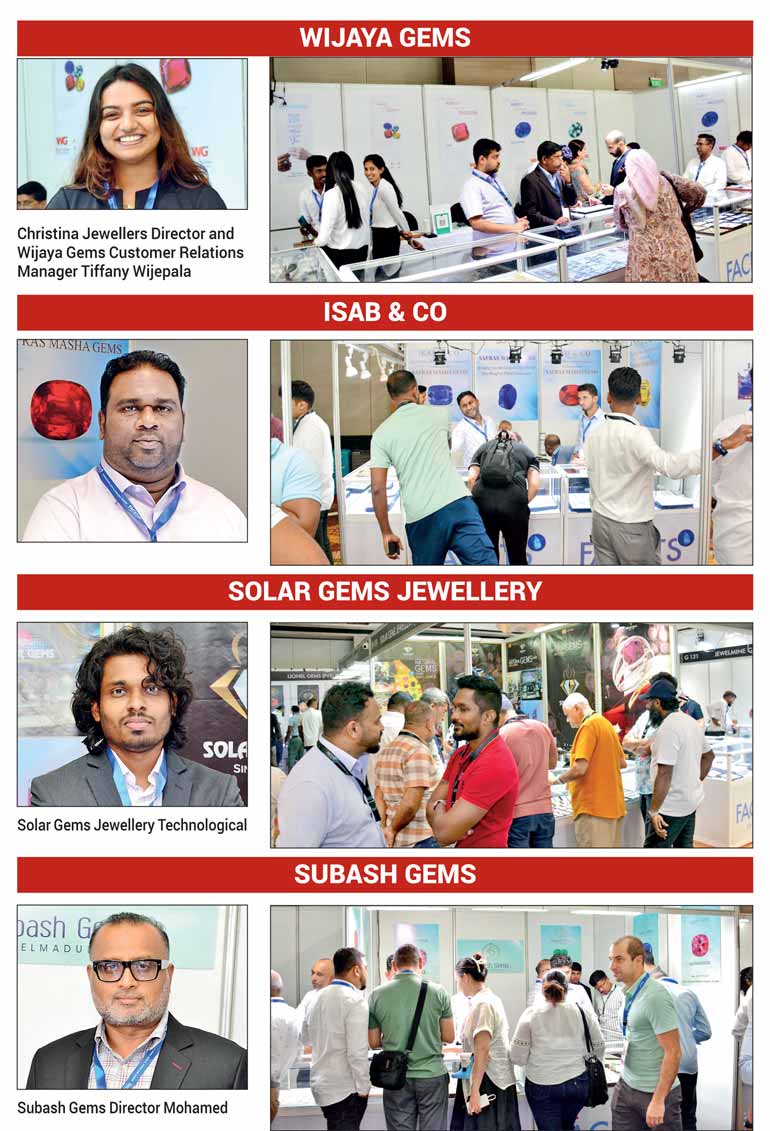Thursday Oct 30, 2025
Thursday Oct 30, 2025
Wednesday, 8 January 2025 00:00 - - {{hitsCtrl.values.hits}}


By Divya Thotawatte
Despite having faced challenges like global recessions and rising costs in the past few years, Sri Lanka’s gem industry remains optimistic about 2025, finding opportunities through exports, tourism and digital platforms to regain its prominence in the world market.
FACETS Sri Lanka 2025 Gem and Jewellery exhibition was held from 4 to 6 January, attracting industry leaders, professionals, buyers and enthusiasts from around the globe as the event showcased the finest gems and craftsmanship the country had to offer. Daily FT spoke to exhibitors and key stakeholders to understand their views on the current state of the industry.
The business leaders shared that despite challenges and drawbacks in recent years, the market was gradually regaining momentum.
Speaking on the challenges the industry has faced over the past few years, Christina Jewellers Director and Wijaya Gems Customer Relations Manager Tiffany Wijepala said, “We specialise in calibrated sapphires and all types of colours ranging from blues, pinks, yellows, and even greens. Over the last year, business has been at a steady decline. We haven’t had a lot of business in this trade just because of the global economic situation. With the wars happening in Israel-Palestine, in China, the economy is not doing so well. Even the US economy is not doing so great. So, when you take all of these global factors, there’s not a huge demand or a place for colour gems, which is like a luxury item.”
Exclusive Jewels Director Arkam Munawwer also agreed that, as exporters of gemstones, business had been slow due to the significant global events that caused a recession in the countries they did business with. While business had picked up well again the next two years after COVID-19, Munawwer said that exporting to countries like the USA, China, Russia, France, Thailand and India over the past year had sometimes been challenging as global issues had affected sales and the market. “Apart from that, we have our regular buyers, and we supply to them regularly,” he added.
Wijepala added that the last year’s elections had also contributed to the uncertainty and insecurity in buyers, but it was now giving way to cautious hope as new leaders took charge and stability returned.
DINIDU Founder and CEO Dinidu Tennekoon, an online precious stone jewellery business owner, had similar views, predicting prosperity for the gem and jewellery industry in 2025. “It’ll be really good for the jewellery industry and gem industry because now, as a country, we are recovering and doing financially well. So people have a lot of buying power, a lot of wealth is being built. I think the market will be really good for us in the coming year.”
Another gem business owner based in Pelmadulla, Subash Gems Director Mohamed Ismail Ahamed Multhazim said that more buyers were already beginning to arrive in Sri Lanka, emphasising that despite being slow right now, he anticipated the sales and business to pick up again over this year.
Additionally, Sri Lankan gems were beginning to gain more recognition again, industry stakeholders highlighted. A jewellery manufacturer and gem cutting company for the German jewellery industry, Solar Gems Jewellery Technological Director Gangulal Wijekoon also said that the Sri Lankan gem industry is headed towards a more successful period than before, especially with the quality of Sri Lankan sapphires receiving increased global recognition.
“Now, tourists and clients are coming steadily to Sri Lanka. Sri Lanka has the most special gems from around the world. The colours and all the qualities of sapphires are very prominent in Sri Lanka. With all those things, the market is a little bit up now, with China, USA and India and all of the countries that are coming to visit Sri Lanka for sapphires.”
Current trends in the industry
Highlighting this recognition and shift to coloured Sri Lankan gems, Tennekoon said, “The industry is expanding to new territories. In the beginning it was only diamond jewellery and now Sri Lankans like to go for other coloured stones as well, especially Ceylon sapphires. There is a lot of tourism happening in Sri Lanka and they’re also looking to buy Ceylon sapphires. That’s a big shift in the market right now.”
Wijepala found that teal sapphires and pink gemstones were increasing in demand along with blue sapphires which have had a stable position as a highly in demand gemstone throughout the years. Isab & Co Director Himas Isab, a sapphire and ruby specialist, said, “Usually it’s the blue sapphire that more people are asking for, and unheated always has a good price. The heated prices have come down a bit in the last one year.”
Meanwhile, as rare stones, padparadscha were also highly in demand, said Munawwer. “Padparadschas, especially from Sri Lanka, are very rare. So, it has a good demand among the foreigners. Now we get a lot of foreigners coming to Sri Lanka.” He also added that currently, customised jewellery had a good demand as well.
Tennekoon further added that lab grown markets were beginning to arrive in the market and may have a significant impact on market trends.
Online sales were another aspect of the industry that Tennekoon highlighted, explaining that more buyers were now interested in online purchases.
“DINIDU was a business which started online. We didn’t have a website and were just selling from Instagram and Facebook. Now we have all the platforms, LinkedIn, Twitter, TikTok everywhere and a full-fledged website. A lot of people are buying from home rather than coming to the store. We see a lot of orders happening like that. We thought in the beginning it was only a small number but now it has changed to big numbers as well. So, we are thinking of expanding more digitally rather than physically. We do worldwide; Sri Lanka, Australia, Canada, US and India and we have a price range from Rs. 64,000 to Rs. 24,000,000.”
Recommendations and areas for improvement
As these transformations take place in the market, appropriate policies should also be implemented to support local businesses and exporters, Isab stressed. “The past few years, the business was not good because it was difficult to do exports and bring in foreign exchange because the policies of the previous government were not very consistent and helpful. So today with the President’s speech, we are hopeful. We are hoping for more exporter friendly policies,” he said, emphasising the need for more consistent policies that supported exports. In exporting high-quality Sri Lankan gems and establishing our mark in the global market, Sri Lanka should explore further possibilities in the European market, said Wijekoon. “It’s better if we can touch down the European market. Most Sri Lankans now touch the India and China markets, but we have more opportunities in the European market.”
Despite Sri Lanka’s reputation for producing high-quality gemstones and jewellery, the industry faces a critical shortage of skilled professionals. Sifani Product Development Design Manager Kosala Kaludeva, representing the prominent designer jewellery manufacturer, explained that this shortage was a serious challenge, as the local industry often struggled to meet demand. He noted that, compared to competitors like Vietnam, Sri Lanka was behind in providing professionals in key areas of the industry.
“We have huge problems with labour and trained professionals – there is a lack of designers, gem-cutters, model-making people, and stone-setting people. There is a vacuum there. We don’t have good training methods or schools. We have very few institutes where they are producing professionals but not for the market requirement. In the future if they want to develop this area, they must have good dialogues between the industry people and the Education or Industry Ministry. If they can cooperate with the technical colleges or a kind of secondary school to promote this industry, maybe we can have more professional people,” he said.
Pix by Upul Abayasekara